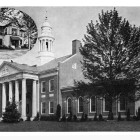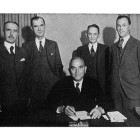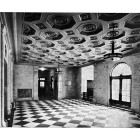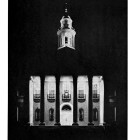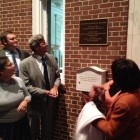Last night Maplewood’s Municipal Building (aka Town Hall) was formally recognized Tuesday for its listing in the National Register of Historic Places with the unveiling of a bronze plaque commemorating the building and its place in Maplewood’s history.
Listing in the National Register of Historic Places is a national honor and recognizes the building’s unique character and the history of Maplewood that it epitomizes. From its perch on the hill overlooking Memorial Park, the Municipal Building has been a prominent landmark in the community for 84 years.
From the Depression to Prosperity
The Maplewood Municipal Building was dedicated in 1932 and its completion is a testament to the tenacity and civic pride of the community. Despite concerns about the costs of construction during the height of the Depression, the Township, under the leadership of Mayor John. S. DeHart continued with plans for the new Municipal Building and its opening was met with great enthusiasm.
One of the first orders of business for the first session of the Township Committee in the new Town Hall was a discussion of the fact that Maplewood could not afford to put up traffic lights at Irvington and Parker Avenues due to the economy.
On September 17, 1932 a grand opening ceremony was held in the same portico where the ceremony last night took place and where the plaque is installed. The 1932 ceremony was attended by hundreds of residents, local officials and those of neighboring towns and included musical numbers, speeches, and presenting of plaques and flags. Stores were closed for the occasion and local buildings were decorated.
Many organizations involved in the dedication are still active today. There was an invocation by the pastor of the Prospect Presbyterian Church, the Maplewood Woman’s Club presented a “tableau “ (The Birth of the Flag), and the Maplewood Post of the American Legion presented state and national flags for the building).
The completion of the Municipal Building and the values of civic pride and community were seen as so significant in representing the Township of Maplewood that the image of the Municipal Building is prominently featured in the center of Maplewood’s seal.
About The National Register of Historic Places:
The National Register of Historic Places is a federal program to recognize buildings, sites and districts that are significant for architectural, cultural, or archeological reasons. Listed properties may be significant examples of a type of architecture, associated with a significant historical person of event or provide information of early settlement.
This designation is an honor and is the culmination of significant work. It is an honor that indicates the significance of the Maplewood Municipal Building to the community, state and nation and as the embodiment of the distinctive characteristics of the Georgian Revival style as demonstrated in its symmetrical façade and plan, Doric colonnade and prominent cupola.
About the Municipal Building:
After Maplewood and South Orange separated in 1904, the town renamed itself the Township of Maplewood in 1922 and community leaders set out to establish a civic center that would define the developing community.
By the mid-1920s, the rapidly growing Township was in desperate need of a new Town Hall, and Police Station, and began to acquire land for new municipal buildings and uses.
Early plans combined the police station and jail with the Town Hall. These plans were altered due to pressure from neighbors and the Township constructed a separate Police Station on Dunnell Road near the new Fire House.
This civic center, including the park and the municipal buildings, was established near the center of the community, on what was once farmland adjacent to the East Branch of the Rahway River and the railroad tracks. This new civic center, with municipal buildings located around the Memorial Park, has become the heart of the Township.
The Municipal Building was designed in the Georgian Revival Style by the firm of Guilbert & Betelle, Architects, a prominent Newark firm that designed schools and government buildings throughout the Northeast. Guilbert & Betelle also designed many of Maplewood’s school buildings, including Columbia High School and Tuscan Elementary School.
National Register Event
Last night, near the start of the regular Township Committee meeting, a bronze plaque located on the outside of the building was unveiled. The event was presided over by Mayor Vic DeLuca for the Township Committee and included a short talk by Virginia Kurshan, Chair of the Maplewood Historic Preservation Commission.

